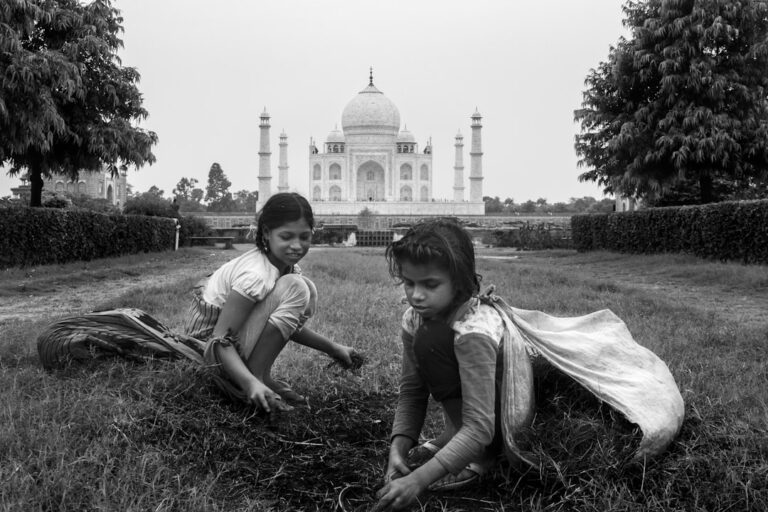The Champaran Satyagraha of 1917 emerged against a backdrop of deep-seated agrarian distress in Bihar, particularly in the Champaran district. The region was primarily an agricultural hub, where the British colonial administration had imposed a system of indigo cultivation known as the “Tinkathia system.” Under this oppressive arrangement, local farmers were coerced into growing indigo on a portion of their land, which was then sold to British planters at minimal prices. This exploitative practice not only stripped the farmers of their autonomy but also left them vulnerable to economic ruin, as they were forced to abandon food crops in favor of indigo, which was less profitable and often unviable due to fluctuating market conditions.
The socio-economic conditions in Champaran were dire.
The situation was exacerbated by natural calamities, such as floods and droughts, which further diminished agricultural yields.
The discontent among the peasantry was palpable, leading to sporadic protests and unrest. It was within this context of agrarian strife that the Kishan Sabha, or Farmers’ Association, was formed in 1917. This organization aimed to unite farmers and articulate their grievances against the colonial authorities.
The establishment of the Kishan Sabha marked a significant step towards collective action, providing a platform for farmers to voice their concerns and seek redress.
Key Takeaways
- Champaran Satyagraha was a significant event in the Indian independence movement, taking place in 1917 in the Champaran district of Bihar.
- Mahatma Gandhi played a pivotal role in organizing and leading the Champaran Satyagraha, which was his first major involvement in the Indian freedom struggle.
- The Champaran Satyagraha had a profound impact on the Indian independence movement, as it marked the beginning of Gandhi’s use of nonviolent resistance as a political tool.
- The Kishan Sabha, a peasant organization, played a crucial role in the Champaran movement by mobilizing and empowering the local farmers to stand up against the oppressive indigo planters.
- The legacy of Champaran Satyagraha and Kishan Sabha continues to inspire social movements in India, serving as a powerful example of how nonviolent resistance can bring about significant social and political change.
- The Champaran Satyagraha and Kishan Sabha offer valuable lessons for social movements, emphasizing the importance of grassroots organizing, nonviolent resistance, and the empowerment of marginalized communities.
The Role of Mahatma Gandhi in Champaran Satyagraha
Mahatma Gandhi’s involvement in the Champaran Satyagraha was pivotal in transforming a localized agrarian struggle into a broader movement for social justice and political rights. Upon receiving reports of the farmers’ plight, Gandhi visited Champaran in April 1917. His arrival marked a turning point; he was not merely an outsider but a leader who embodied the principles of non-violent resistance and civil disobedience.
Gandhi’s approach was rooted in empathy and understanding; he sought to engage with the farmers directly, listening to their stories and grievances. This grassroots engagement allowed him to grasp the nuances of their struggles, which would later inform his strategies for mobilization. Gandhi’s methodology in Champaran was characterized by his commitment to non-violence and truth.
He organized a series of meetings with local farmers, encouraging them to stand up against the injustices they faced. His presence galvanized the community, instilling a sense of hope and empowerment among the oppressed. Gandhi’s insistence on peaceful protest was crucial; he believed that moral authority could be wielded against colonial power without resorting to violence.
This philosophy resonated deeply with the farmers, who had long been subjected to brutality and exploitation. By framing their struggle as a moral one, Gandhi not only elevated their cause but also laid the groundwork for future movements across India.
The Impact of Champaran Satyagraha on the Indian Independence Movement

The Champaran Satyagraha had far-reaching implications for the Indian independence movement, serving as a catalyst for subsequent protests against British rule. It marked one of the first instances where Gandhi’s principles of non-violent resistance were successfully implemented on a large scale. The success of the Satyagraha demonstrated that organized, peaceful protest could yield tangible results; it compelled the British government to appoint an inquiry committee to investigate the grievances of the farmers.
This outcome not only validated the farmers’ struggles but also showcased Gandhi’s ability to mobilize mass support around a common cause. Moreover, the Champaran movement inspired other regions in India to adopt similar strategies in their own struggles against colonial oppression. The principles of Satyagraha became foundational to various movements that followed, including the Non-Cooperation Movement and the Civil Disobedience Movement.
Gandhi’s success in Champaran also attracted a diverse array of supporters from different social strata, including intellectuals, students, and women, thereby broadening the base of the independence movement. The event underscored the importance of grassroots activism and collective action, setting a precedent for future campaigns that would ultimately lead to India’s independence in 1947.
The Significance of Kishan Sabha in the Champaran Movement
The Kishan Sabha played an instrumental role in organizing and mobilizing farmers during the Champaran Satyagraha. Established as a response to the agrarian crisis, it served as a unifying force for farmers who had long been fragmented by colonial policies and local power dynamics. The Sabha provided a platform for farmers to articulate their grievances collectively, fostering a sense of solidarity among them.
This collective identity was crucial in empowering farmers to confront their oppressors and demand justice. The Kishan Sabha also facilitated communication between farmers and leaders like Gandhi, ensuring that their voices were heard at higher levels of political discourse. It organized meetings, rallies, and demonstrations that brought attention to the plight of farmers not only within Bihar but across India.
By mobilizing public opinion and garnering support from various quarters, including educated elites and political leaders, the Kishan Sabha amplified the farmers’ demands for rights and justice. Its significance extended beyond Champaran; it inspired similar organizations across India that sought to address agrarian issues and advocate for peasant rights.
The Legacy of Champaran Satyagraha and Kishan Sabha in Indian History
The legacy of the Champaran Satyagraha and the Kishan Sabha is deeply embedded in India’s historical narrative as symbols of resistance against colonial oppression. The successful mobilization of farmers under Gandhi’s leadership not only highlighted the potential for non-violent protest but also established a framework for future movements advocating for social justice and political rights. The principles articulated during this struggle—such as self-reliance, unity among marginalized communities, and non-violent resistance—continue to resonate in contemporary social movements across India.
Furthermore, the impact of these events can be seen in subsequent agrarian movements that emerged throughout India in response to various forms of exploitation and injustice. The lessons learned from Champaran have informed strategies employed by farmers’ organizations today as they confront issues such as land rights, fair pricing for crops, and environmental sustainability. The legacy is not merely historical; it serves as an enduring reminder of the power of collective action and moral courage in challenging systemic injustices.
Lessons Learned from Champaran Satyagraha and Kishan Sabha for Social Movements

The Champaran Satyagraha offers several critical lessons for contemporary social movements seeking to effect change. One of the most significant takeaways is the importance of grassroots mobilization.
Modern movements can benefit from this model by prioritizing community engagement and ensuring that those most affected by an issue are at the forefront of advocacy efforts. Another vital lesson is the efficacy of non-violent resistance as a strategy for social change. Gandhi’s commitment to non-violence not only garnered moral authority but also attracted broader support from diverse segments of society.
In today’s context, where polarization often characterizes social issues, adopting non-violent methods can help bridge divides and foster inclusive dialogue. Additionally, the role of organizations like Kishan Sabha underscores the necessity of collective action; social movements thrive when individuals unite under a common cause, amplifying their voices and demands. Finally, the Champaran Satyagraha illustrates that sustained advocacy requires patience and resilience.
Change often takes time, and setbacks are inevitable along the way. However, through persistent efforts grounded in ethical principles and community solidarity, meaningful progress can be achieved. As contemporary social movements navigate complex challenges—be it climate change, social justice, or economic inequality—the lessons from Champaran remain relevant, guiding activists toward effective strategies for achieving their goals while fostering unity and resilience within their communities.
The Champaran Satyagraha and Kishan Sabha were pivotal moments in India’s fight for independence and social justice. These movements highlighted the importance of education and empowerment of the masses. A related article that delves into the relationship between society and education as a key driver of development can be found here. This article explores how education plays a crucial role in shaping societies and driving progress. By understanding the impact of education on social change, we can appreciate the significance of movements like Champaran Satyagraha and Kishan Sabha in empowering communities and driving towards a more just society.
FAQs
What is Champaran Satyagraha?
Champaran Satyagraha was a movement led by Mahatma Gandhi in 1917 in the Champaran district of Bihar, India. It was the first time Gandhi used non-violent civil disobedience as a political weapon.
What was the cause of Champaran Satyagraha?
The main cause of Champaran Satyagraha was the exploitation of the local farmers by British indigo planters. The farmers were forced to grow indigo and were subjected to unfair treatment and excessive taxation.
What was the outcome of Champaran Satyagraha?
The outcome of Champaran Satyagraha was a significant victory for the farmers. The British government agreed to abolish the system of forced indigo cultivation and to improve the farmers’ working conditions.
What is Kisan Sabha?
Kisan Sabha, or the All India Kisan Sabha, is a peasant organization in India. It was founded in 1936 with the aim of fighting for the rights of the farmers and peasants.
What was the role of Kisan Sabha in the Indian independence movement?
Kisan Sabha played a crucial role in the Indian independence movement by mobilizing the farmers and peasants against the oppressive policies of the British government and the local landlords. It also worked towards the upliftment of the rural poor and the improvement of their living conditions.






















+ There are no comments
Add yours